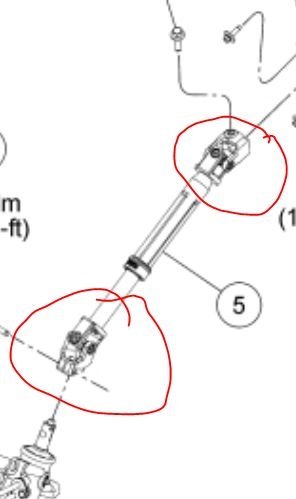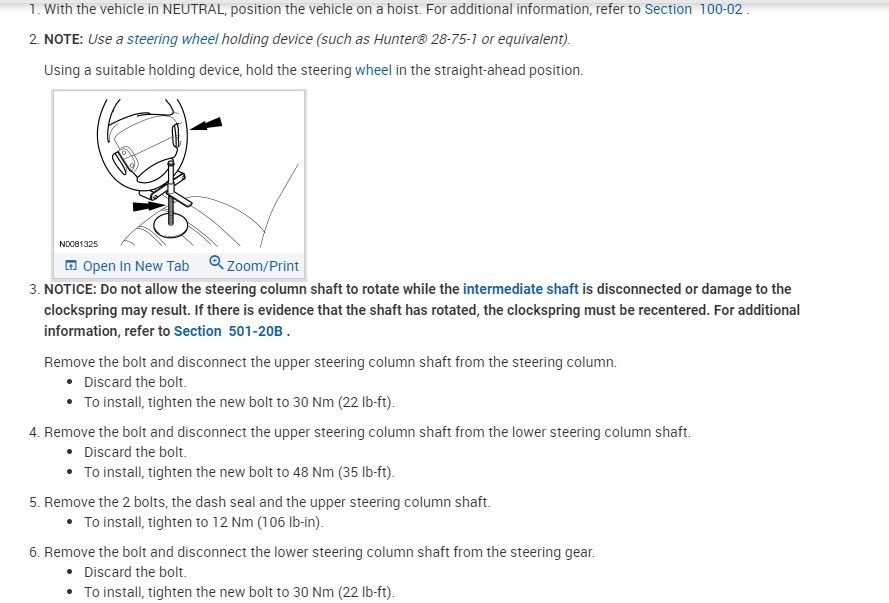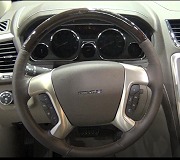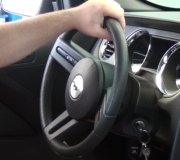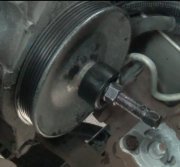Not likely. There's two common causes of this. One is a tight ball joint, and that can be affected by raising the truck on a hoist. Raising it doesn't cause the problem. It allows it to occur when that ball joint is already worn and ready to be replaced. By removing the pressure on it, dirt and rust is able to sneak into places where it causes the joint to bind when the truck's weight is placed on it again. This is real common on Fords that use a solid front axle housing or the I-beam front axle. It's less common with individual upper and lower control arms.
A less-likely problem is one of the main three alignment angles is too low, but that wouldn't change on its own. That's "caster". It is visualized as looking at the top ball joint is rearward of the lower one, as viewed from beside the wheel. (Think of how the fork on a bicycle tilts rearward on top). Caster's main purpose is to decrease steering wander, and it is what causes the steering wheel to come back to center on its own after turning a corner.
The hint is with too little caster, the steering wheel will center itself, but too slowly. Caster decreases when the rear of the vehicle is raised higher than specified. With tight ball joints, the steering wheel will tend to stay off-center until you pull it back by hand. It might come halfway back to center, but it won't make it all the way. Along with this, you'll observe the tightness in having to constantly correct the steering on straight roads. That makes for a very tiring vehicle to drive.
Caster is adjusted during an alignment, but with solid front axles or with the I-beam axle, that is an extremely time-consuming and difficult adjustment to make. That doesn't have to be done often since it can't really change much on its own. Caster is easier to adjust, and easier to slip out of adjustment, when you have the upper and lower control arms. The clue there when it slips on one side is it will cause a pull toward the side with the lower caster.
A technical point that can confuse the issue is caster on one wheel goes up when it turns away from the truck, and it goes down when turning toward the center of the truck. There is no way to measure that directly, but for purposes of this explanation, the steering system always wants to move to where caster is equal on both sides. When the left side is lower, for example, than the right side, they will be equal at some point where both are turned to the left. That is where the left-hand pull comes from. With this caster pull, the steering wheel will come to rest off-center to the left when you let go of it. That can be confused as the steering wheel doesn't come back to center. The clue here is you have to pull it back to centered by hand, then, when you let go of the steering wheel, it will move back to the left on its own. With tight ball joints, you won't have that pull and the steering wheel will stay centered when you put it there.
As for universal joints, steering problems can occur when one in the front becomes tight. Those are the two out by the ball joints. In this case it isn't a failure to come back to center. It's just the opposite. The joint doesn't like to rotate. Instead, it wants to stay straight, so when you try to turn the steering wheel, the u-joint forces it back to center real hard. To identify this, you'll observe that if the truck is standing still with the engine running, you can turn left or right as easily as normal, then drive forward one quarter tire revolution, and you'll find you can't turn the steering wheel. Drive ahead another quarter tire revolution, turn the steering wheel to one side, then try to drive forward and the steering wheel will be forced back to center harder than you can hang onto it. In every case where I found one of these, at least one of the bearing cups was either full of rust-colored powder and the bearings were gone of broken, or the cup was cracked and falling apart. They're rarely tight without some visible indication.
If there's a tight universal joint in the steering shaft, (on vehicles that have them), you can feel the tightness when you turn the steering wheel, but it feels different than a tight front axle shaft universal joint. With these, there's two tight spots in every steering wheel revolution, as compared to one big tight spot between centered and full-left or full-right. Also, moving forward won't affect anything in the steering shaft. When a tight part forces the steering system to come back to center when the truck moves, it has to be caused by something that is rotating, in that case, the axle's u-joint.
Thursday, January 16th, 2020 AT 5:08 PM
